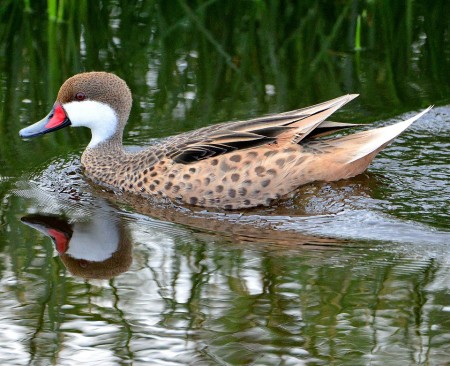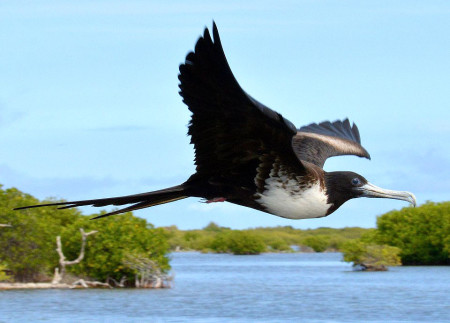
Joseph Prosper shares with us his experiences birding in Barbuda and the choices this pristine little island faces. He discusses the importance of conservation and provides wonderful insights into the birds found here.
Barbuda is definitely torn between two lovers and probably feeling like a fool. This island holds two tomorrows in its hands. One is for it to remain a remote, low-key eco-tourism destination, with a small economy that preserves and features the island’s wealth of pristine natural resources and traditional culture. The other tomorrow is Barbuda becoming a tourist destination with mega resorts, modern lifestyles and greatly lessened natural beauty.
Climate change looms over both of these tomorrows, as the low relief is highly threatened by sea level rise. This is their moment to consider and decide. I know what I would choose.
I have been involved in bird watching for 14 years. I crudely define this activity as a form of wildlife observation in which the observation of birds is a recreational activity. Watching birds in Barbuda can be done with the naked eye, through binoculars or by listening for bird sounds. Surprisingly, in Barbuda, many bird species are more easily detected and identified by ear than by eye. Most birdwatchers, including myself, pursue this activity for recreational and social reasons. I have also engaged in the study of birds using formal scientific methods. Many birdwatchers maintain life lists, a list of all of the species they have seen in their life, usually with details about the sighting, such as date and location. The criteria for the recording of these lists are very personal. Some birdwatchers “count” species they have identified audibly, while others only record species that they have identified visually. Some maintain a country list, parish list, state list, county list, yard list, year list, or any combination of these.
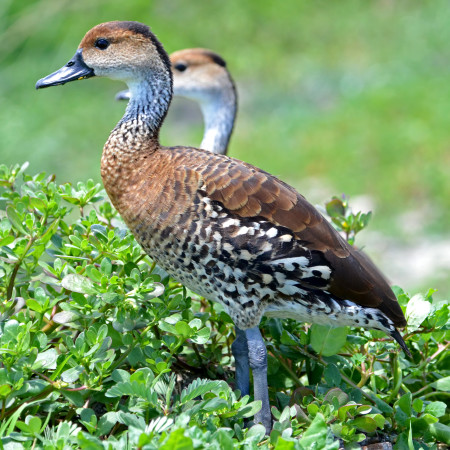
My ‘birding’ life started in 2002 when I attended a “West Indian Whistling-Duck and Wetlands Education Training Workshop led by Dr. Lisa Sorenson of BirdsCaribbean (formerly the Society for the Conservation and Study of Caribbean Birds) and the Environmental Awareness Group (EAG).
This was my introduction to the West Indian Whistling-Duck which sparked and sealed a lasting interest in birds and birding. This tall, graceful, brown-spotted duck is found only in the West Indies. It was once abundant and widely distributed throughout the Caribbean, but is now scarce and limited in its distribution due to illegal hunting, introduced predators like the mongoose which eat eggs and ducklings, and loss of much of its wetland habitat from development. In my pursuit of the duck, I traversed little known parts of Antigua and Barbuda, spending many hours observing the duck and widening and deepening my knowledge and experience with birds. My fascination and surprise grew as I realised through my association with other local birders, notably Victor Joseph and Andrea Otto, that as small and as dry as Antigua and Barbuda is, the country hosts well over 182 species of birds including numerous migrants.
Unlike many birders, I do not have a life list, but strive to see as many birds as possible, and rarities and endemics are at the top of my list.
I was therefore thrilled to learn that, as tiny as my country was, Barbuda is home to the endemic Barbuda Warbler, recently elevated to species status after genetic research deemed it worthy of this designation.
One of my best birding moments was setting eyes on this warbler in 2005. My guide, Mr. Calvin Gore, took me to the spot for the Barbuda Warbler. This is quite easy to find: Going south on the main road, about 2 miles from the airport is a thick section of pipe on the left. There is an embankment about 100-200 feet to the left, which holds water occasionally, but was bone dry with no signs of having been a pond on my visit. There is a pond on the right as well, mostly dry. Just before reaching the embankment I heard a warbler sing, and shortly thereafter spotted the Barbuda Warbler, flitting about in the dry scrub. It is a beautiful little bird with gray upperparts, bright yellow underparts, a yellow line above the eye and a yellow or whitish crescent below it. I saw and heard many Barbuda Warblers during the 3 hours I spent here.
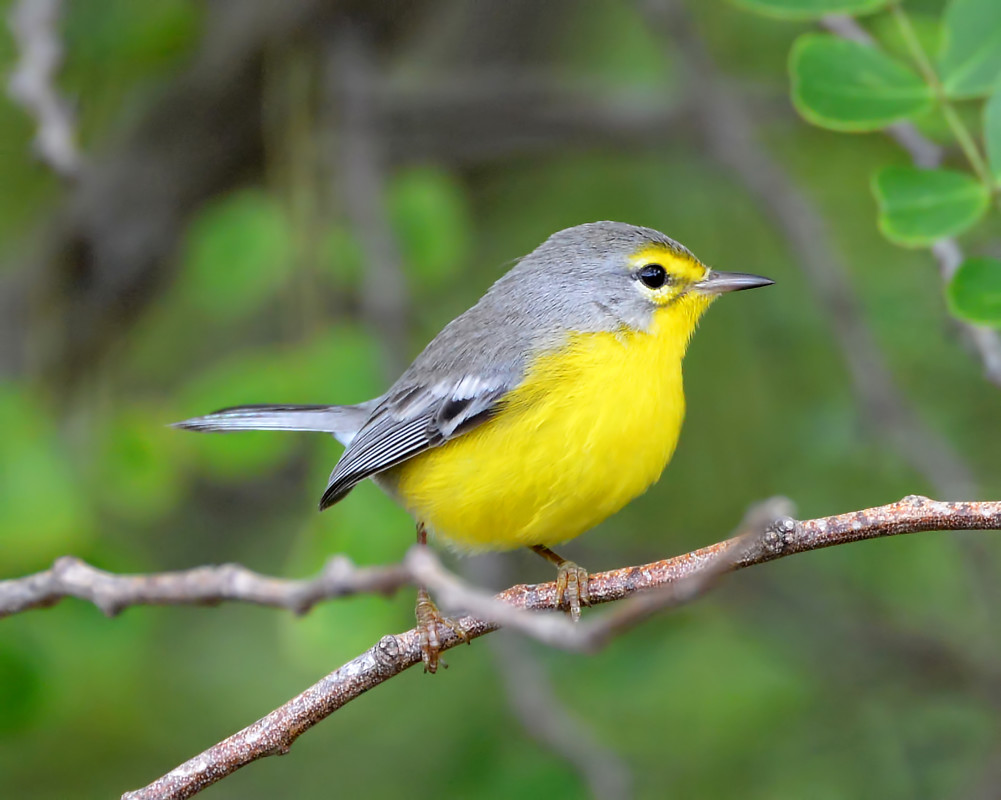
I spooked a pair of Helmeted Guineafowl and got excellent looks at Lesser Antillean Flycatcher, Mangrove Cuckoo, and Caribbean Elaenia. I saw many migrant and resident shorebirds and waterbirds, including White-cheeked Pintails, Stilt Sandpipers, Short-billed-Dowitchers, Black-necked Stilts, Wilson’s Plover, White-rumped Sandpipers, Common Snipe, and a pair of Pectoral Sandpipers. I walked around the town—there were Cliff Swallows with Barn Swallows at the airport, supposedly rare for Barbuda. There is a place in the lagoon where West Indian Whistling-Ducks come in the evening, uttering their beautiful haunting whistling call as they fly in. Visiting Barbuda to see the warbler and the many other special birds that one can see in Barbuda makes it a worthwhile trip for any birder or nature lover.
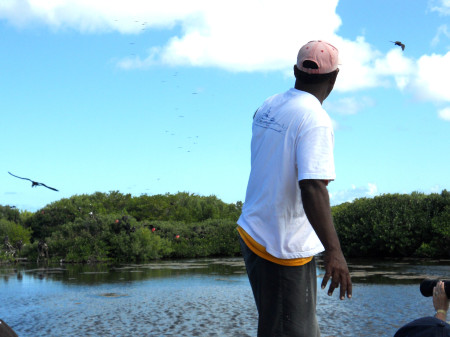
My love affair with birds and birding led to my membership in BirdsCaribbean, a non-profit regional organization dedicated to studying and conserving Caribbean birds and their habitats, and my travels all over the Caribbean including Trinidad, Tobago, Puerto Rico, Grenada, Jamaica, Montserrat, Guadeloupe and beyond to Canada, South America and Europe. Birding allowed me to feed my other great love which is education. I studied birds, focusing on the West Indian Whistling-Duck, and advocated for their conservation on Antigua and Barbuda. and delved into the ways of any bird I encountered. I happily shared my discoveries with many children, residents, and visitors wanting them to experience a similar amazement at the world of birds.
At the Codrington Lagoon in Barbuda where the Magnificent Frigatebird engaged my attention – oh what a sight for my eager eyes! I took a small boat from the harbour in Codrington to the Frigatebird Sanctuary in the northwest of the lagoon. I thoroughly enjoyed the crossing and at the sanctuary I was taken within 2 metres of thousands of birds nesting on top of clumps of short Red Mangrove bushes. They were totally unmoved by my presence. Surveys show there are over 5,000 frigatebirds using the site, making it the largest colony in the Caribbean. It is really something to see these birds and the way they live in the wild. By this time George Jeffrey, my tour guide, was moving me along with a pole, the boat was silent except for the sound of my camera shutter. I was there during mating season (February) and it was fascinating to see the males puffing out their brilliant red neck pouches to attract the females. I could hear the sound of the males drumming their pouches all around me.
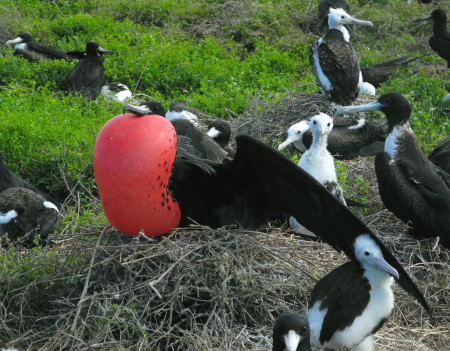
Fascinated, I asked where the ‘downies’ go when there is a hurricane? “When there’s a storm the babies climb deep into the mangroves and wait it out, while the adults fly away,” George said. “Some people call them Weather Birds, because there will be hundreds of them going off in a cloud before the storm hits.” George then provided a demonstration of how important sticks are to the male frigatebirds for building their nests. He threw a stick up in the air and then gave a play-by-play commentary of the male frigates fighting over the stick and even pulling it away from another bird while in flight until they could find a way back to their nest. There were males displaying, chicks and females sitting on nests—an incredible sight. A definite must-see if one is in Barbuda.
My hope is that these birds and the pristine nature of Barbuda will still be here for generations.
Let’s choose a tomorrow that does not succumb to the bulldozer but instead preserves this natural wealth for all to experience and enjoy.
By Joseph (Junior) Prosper, schoolteacher in Antigua and dedicated local conservationist. Reprinted with permission from the tourism coffee table book: Simply Antigua Barbuda. The book is available to order online at this link. The online version of the book can be viewed here.
To learn more about birds and birding in the Caribbean, visit BirdsCaribbean and the Caribbean Birding Trail. We encourage you to support the conservation of the Caribbean’s unique birds and wildlife by joining a local environmental group such as the Environmental Awareness Group of Antigua & Barbuda.
